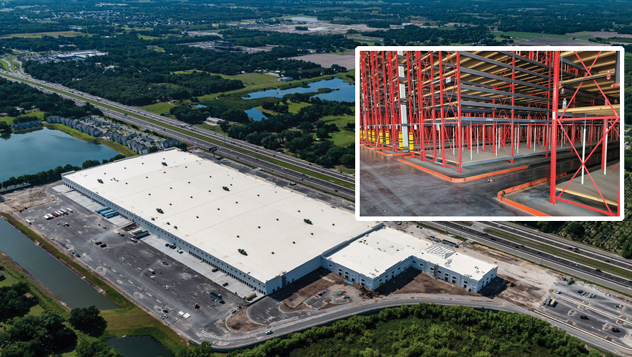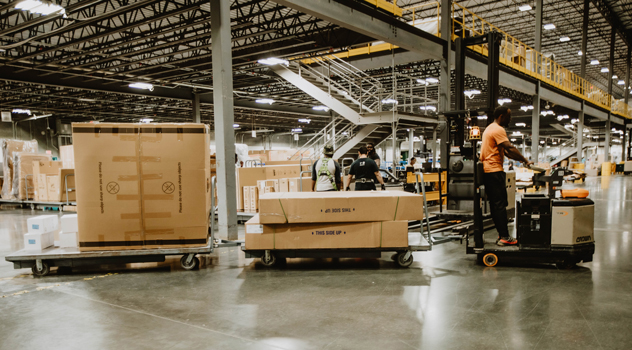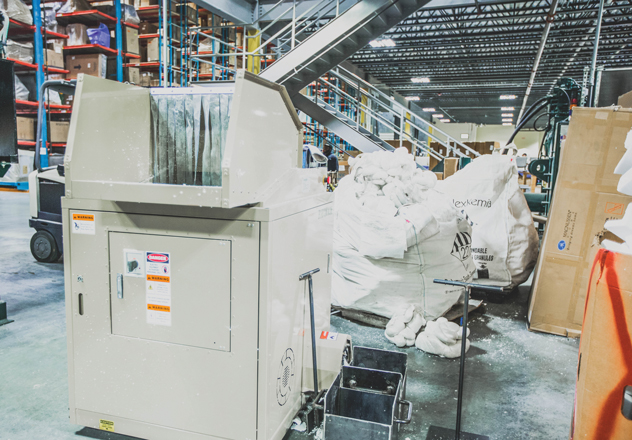Interview with Billy Lindler, USSI
Many retailers need to focus more on managing their warehouse cube. That
requires identifying and updating poor performing systems. Many cost-saving
fixes are low-cost or no-cost.
Furniture World recently spoke with Billy Lindler Jr., president of USSI, a
company that partners with furniture retailers to provide services,
including operations, expansion and new construction consulting, facility
audits and warehouse inspections. Lindler offered insight into how retailers
can improve their warehouse operations and prepare for future challenges and
technological advances.
State of Furniture Warehouses
“I visit at least one furniture retail warehouse per week, and overall,”
Lindler noted, “they reflect softening demand causing some to be
significantly full or overflowing. During the pandemic, retailers we worked
with leased additional warehouse space and adopted a precision approach to
engineering warehouse design based on the cubic volume of inventory they
needed to keep on hand. Many had problems with their saleable inventory mix.
For example, too many headboards and rails, but not enough footboards. The
best operators cleaned out inventory waiting for parts that were demised,
discontinued or damaged. Others still have a shocking amount of cash tied up
in this kind of inventory and even misplaced inventory.“
Background
Lindler started working at USSI, founded by his father, as a teen. After
earning an industrial engineering degree from Georgia Tech, he rejoined the
family business for a short stint. He then left USSI to join the world’s
largest automated material handling company, first working as an engineer
and then selling warehouse management system software to Fortune 500
companies. He also spent time at the enterprise software providers, Siemens,
SAP and Dassault Systemes.
Just over five years ago, Lindler did some consulting for USSI and was asked
to stay on as company president. “That was an offer I wasn’t expecting,” he
shared. “It’s been a fantastic journey since then. We’ve leveraged the solid
foundation USSI has in the marketplace by bringing to bear the
organizational skills I learned while away from the business.”
“Advanced systems can handle warehouse route planning, also known as
interleaving, to coordinate different tasks to maximize warehouse
efficiency.”
Warehouse Challenges
Lindler, who has an obvious affection for retail operations, said he’s yet
to meet a furniture retailer who entered the furniture business because they
had a passion for managing a warehouse. But as the operations side has
become more critical to retail profitability, the need to focus on warehouse
efficiency head-on has increased dramatically.
What’s Required
Selling bedroom sets requires salespeople to walk customers through the
steps of the sale to help them find the one collection they like the best.
Presentations must be based on the customer’s specific needs, skillfully
utilizing all the appropriate FABs. Then, the sale must be closed in a way
that includes all the right pieces they will need.
-
Labor Challenge: “The competition for warehouse workers
is intense right now. Aside from low unemployment in many areas of the
country,” said Lindler, “all kinds of businesses are gobbling up workers
to get inventory closer to the point of purchase. It’s not just Amazon.
Others are making significant investments in distribution operations as
they scale back retail footprints in favor of web-based sales models.
Furniture retailers are having an especially difficult time finding
help. There are reasons for that. Most warehouse jobs involve sitting or
standing on a fork truck, driving around, and moving pallets with a
machine. In furniture warehouses, employees slide and lift 350-pound
power motion sofas. It’s a lot of physical activity. A study we
conducted revealed that the average order picker operator moves 10,000
pounds of furniture daily. It’s a significantly more demanding job than
working for Publix in South Florida or at Amazon with the help of a Kiva
robot.”
Recruiting Challenge: Lindler said that retailers have
limited options, but some things can be done in addition to continually
looking for new warehouse talent. “Some retailers are enlisting
employees to help find new workers by giving them bonuses. It’s a
friends-of-friends recruiting approach with a financial incentive.”
Work Schedules: “Retailers are becoming more aware of a
need to make work schedules less demanding for warehouse employees to
create a more family-oriented work environment.”
Workplace Culture: “It’s important to address the three
C’s: culture, compensation, and calendar. Operationally, some of the
best organizations have moved the needle forward by addressing workplace
warehouse culture through employee recognition programs. Consider
bringing employees together for meals or in settings such as an annual
gala to provide an opportunity for peer recognition and fun.”
“In the coming years, there will be increased use of robotics and perhaps
the adaptation of a Reliable technology called Automated Storage and
Retrieval Systems (ASRS).”
-
Equipment Lead Time Issues: “Current lead time for
order picker delivery is about 60 weeks. So, some of our clients have
ordered these machines before they break ground on new warehouse
construction. Avoid unpleasant surprises by keeping track of equipment
that’s nearing retirement. Lift equipment commonly used in furniture
warehouses is specialized and purpose-built for furniture. There aren’t
nearly as many of these used machines available for purchase as less
specialized equipment.
“On the repair side, components like wheels and casters are readily
available, but electrical components like circuit boards and ICs can
sometimes be more difficult to source. Overall, service suppliers have
done a decent job of managing that inventory and keeping it available.”
-
Construction Delays: “Aside from lift equipment delays,
lead times and material costs are moderating. The cost of steel used to
produce storage racks, which increased by 300 percent during the
pandemic, has returned to near pre-COVID levels. However, projects have
been delayed due to shortages of concrete and electrical panel
availability. Even leased build-out for a developer spec building has
been, and continues to be, quite challenging.”
-
Extra Costs:
“The availability of what I call ‘beachfront’ land suitable for new
distribution center construction,” Lindler observed, “is another problem.
Prices for large lots near an interstate interchange have risen by 100
percent over the past couple of years. Construction costs have also
increased with no recent softening in the market.”
Software Solutions
Furniture World asked Lindler to provide information about the
implementation of warehouse management system software.
“Advanced systems,” he advised, “can handle warehouse route planning, also
known as interleaving, to coordinate different tasks to maximize warehouse
efficiency.
“So many stores we visit,have items in the warehouse that can’t be found on
their showroom floors. What that means in practice is that these SKUs will
remain in warehouse purgatory forever.”
“Let’s say that an order picker pulls a cart full of furniture into a guided
warehouse aisle. Once there, it can go full speed with no steering required.
Order pickers are 20-foot-long machines that lack agility and are not adept
at changing aisles. That’s why after an order picker unloads, it makes sense
for it to perform as much work as possible by immediately flipping to order
picking before changing aisles. Interleaving, controlled by WMS, ensures
that the picker goes in full and comes out full. Carts are transported with
a tugger so that it can do as much work as possible, as efficiently as
possible. Interleaving eliminates deadheading, which reduces labor costs,
wear and tear on machines and the number of order pickers needed.”
Lindler explained that “Efficient interleaving is rarely accomplished when
using what I would call a brute-force system, but it can be done manually.
First, a warehouse manager prints out received and scheduled outbound orders
every day. This paperwork is sorted by aisle, so the information is
available for picks.
“A problem that often arises with a manual system is that should there be a
substitution or a delivery cancellation, the paperwork needs to be
reshuffled to adapt to the changes.
 New warehouse projects have been delayed due to materials shortages. At
right, new warehouse construction and racking includes a guidance system
to protect racking and equipment. Soon advanced order picker technology
will allow for taller warehouses with smaller footprints.
New warehouse projects have been delayed due to materials shortages. At
right, new warehouse construction and racking includes a guidance system
to protect racking and equipment. Soon advanced order picker technology
will allow for taller warehouses with smaller footprints.
“There are a number of software solutions retailers use. Some are part of
popular furniture software applications that also control POS and other
retail functions. There are also purpose-built applications that keep track
of warehouse inventory from when it gets scanned off the truck, put into a
receiving area, loaded on a cart, then into a storage location. The
advantage is that the system knows, for example, that a specific SKU is in
row 12, bay seven, level two. When the system calls for delivery of an item,
the system identifies the location of the oldest one in inventory or perhaps
finds a returned item already out of its packaging that’s still as good as
new and ready for delivery. Bad things happen to furniture that’s been
unboxed. Likewise, WMS can handle other functions necessary to help manage
the returns process and the disposition of inventory. These include
answering questions such as:
- If it’s a return, is it being sent for repair?
- Do we need to order parts?
- Should an item go to clearance, be donated or be put in the trash?
“Again, the process can be managed with a manual form. Technology is great,
but to be successful, retailers must focus on people, processes, and
technology in that order.“ Some systems our clients have used are
InfinityQS, a system that Dearden’s developed; GERS, a point of sale legacy
solution; BXK, from Warehouse Architects; HighJump; and STORIS.
Warehouse Danger Signals
Safety: “People’s livelihoods and the well-being of
families need to be every retailer’s first priority,” Lindler told Furniture
World. “If there were significant workers’ comp claims and other safety
issues, it’s a red flag. ”
Poor Performance: “Another,” he said, “is failing to meet
targets for key performance indicators. Sometimes I ask business owners
about their KPIs and get blank stares. Without tracking KPIs across all
departments, including benchmarks for sales, marketing, warehouse
operations, delivery, hiring and employee satisfaction, it’s impossible to
measure performance, difficult to coach, and hard to improve. Retailers
can’t monitor what they’re not measuring. Just having sales figures and
knowing how many deliveries are made every day is not enough.”
When asked how to develop KPIs and identify those that under-perform,
Lindler suggested that “It can be useful to have someone perform an audit to
get baseline data on safety, facilities, and operations. It’s also a good
idea to compare operations with similar furniture retailers. There are some
good performance groups in our industry. USSI has one as well that
specializes on the operations side. Its members find it useful to compare
KPIs such as cubes-per-man- hour among their peers.”
Missing Inventory: “Another danger signal is lost
inventory, even if it’s just one brown leather $1,000 sofa. No retailer
likes to call a customer to say, ‘Thanks for buying the sofa. We’re working
on delivering it as soon as we find it.’ This represents a broken promise.
Just last week I spoke with a retail owner who misplaced an entire
container. Situations like these are disturbing because when retailers fail
to invest in warehouse operational excellence, so much is at stake regarding
the total customer experience. When done the right way, the result is lower
rates of damage, as well as decreased labor costs and consumer
dissatisfaction.”
“Today, the standard max for order pickers is 30.5 feet. In the next 12 to
24 months, manufacturers plan to introduce models that reach into the 45- to
55-foot range with increased capacity.”
Inventory Control Issues: “Poor inventory control,
including shrinkage, is an additional cause for concern. It’s important to
keep track of saleable inventory by keeping up with cycle counts. So many
stores have items in the warehouse that can’t be found on their showroom
floors. What that means in practice is that these SKUs will remain in
warehouse purgatory forever. This can quickly get out of hand. Recently,
when doing a warehouse audit, we found that 20 percent of a retailer’s cube
was not displayed on its sales floors.”
Lack of Management Attention: Retail store owners and managers are busy
people. This can result in warehouse management operations upgrades often
getting put on the back burner. “They have other urgent business
priorities,” explained Lindler. “They may be in the middle of opening a
new showroom or say they’ve managed their warehouse in the same way
‘forever,’ and it works fine. But if nobody is paying close attention to
what’s going on in the warehouse with the intent of improving operations,
it’s a danger signal as well.”
 Carts are transported with a tugger so that as much work can be done as
possible in an efficient manner.
Carts are transported with a tugger so that as much work can be done as
possible in an efficient manner.
Don’t Ignore the Simple Things: Lindler completed his list
of warehouse danger signals with this observation. “Retailers often shoot
themselves in the foot by ignoring the simplest things. For example, not
paying attention to graphics on warehouse boxes indicating storage
orientation. This information is always printed on boxes with the words
‘this end up,’ or by a black line on one side that indicates the side where
a box should contact the shelf to avoid damage. This black line may extend
around the edges as well, with the top left purposely blank to indicate that
either there’s lack of necessary protective packaging on top to protect an
item, or the item has delicate elements there that are easily damaged. Glass
furniture may have red lines with added text that reads ‘fragile.’
“It’s hard to believe there are so many warehouse operators, assistant
managers and managers who don’t know what the black lines mean. It’s common
for racks to be full of furniture that is stacked helter-skelter due to lack
of attention or poor training. Even boxes clearly marked ‘fragile’ with red
arrows that should point up, often point down.
“Remedying this situation doesn’t require a costly warehouse management
system, new racks or order pickers. It just requires staff to follow the
instructions on the box! Items like dressers aren’t designed to be flipped
upside down and banged around on an order picker or on their journeys
through the warehouse. Just a couple of weeks ago, I toured a facility
accompanied by its DC manager. I kept taking pictures of mis-stacked
furniture until I felt a bit sick to my stomach. It turned out that he
didn’t know what the black lines meant. Nobody in the warehouse did.”
“Current lead time for order picker delivery is about 60 weeks. So, some of
our clients have ordered these machines before they break ground on new
warehouse construction.”
Tech Advances & Best Practices
There are many new advances on the horizon, as well as best practices
already in place that can help furniture retailers improve operations. Here
are some that are interesting.
3D Product Data: Warehouse management systems providers are
working on new ways to make warehouses more efficient. “One,” identified
Lindler, “that’s interesting is the adaptation of 3D product photography
commonly seen on consumer-facing websites and in-store kiosks. Once package
dimensions are added to that 3D information, it will routinely be used in
ways to better manage the warehouse cube.”
Product Data Entry: “City Furniture is ahead of most
furniture retailers with regard to data collection,” Lindler observed. “Upon
receiving, they record useful information about every new SKU. The goal is
to facilitate put-away based on each product’s sales velocity, weight and
box dimensions. Fast-moving SKUs are positioned towards the front of the
warehouse because those trips are more frequent. Slow movers are located
toward the back. Items in the mid-ranges are also placed according to their
velocity. The system continually adapts based on sales volume changes over
time.
 Pictured above are incorrectly oriented boxes. Lindler said that it’s
hard to believe that many assistant managers and managers don’t know
what the black lines on the boxes mean.
Pictured above are incorrectly oriented boxes. Lindler said that it’s
hard to believe that many assistant managers and managers don’t know
what the black lines on the boxes mean.
“Some manufacturers are helping retailers by providing box dimensions and
weights, but even with that information, problems can arise in warehouses
with merchandise that was assembled and returned before delivery to
customers’ homes.
“Let’s say a retailer delivers six chairs and a dining room table that was
received knocked down without legs. It’s assembled for delivery, but should
it be returned, it can’t fit back in the same warehouse slot. And so,
collecting and managing dimensional data based on assembled and unassembled
size turns out to be very important information for furniture retailers to
have as well. Likewise, when a new product that requires assembly is
delivered to a warehouse for the first time, some of the best retailers
measure assembly time so they can do production planning to coordinate
anticipated volume during, for example, a Presidents’ Day sale on a $399
dinette and six chairs that will need to be assembled before delivery.
“The bottom line,” Lindler concluded, “whether a retailer uses a WMS or
manual system, a best practice is to start capturing the information needed
to make decisions about how products get stored based on unassembled and
assembled (in box) dimensions, velocity and weight.”
Taller Warehouse Construction: “In the near future, we will
see advances in warehouse automation and improved lift equipment that will
allow retailers to build smaller footprint warehouses by building higher,”
Lindler predicted.
“It’s common for racks to be full of furniture that is stacked
helter-skelter due to lack of attention or poor training. Even boxes clearly
marked ‘fragile’ with red arrows that should point up, often point down.”
“Today, the standard max for order pickers is 30.5 feet. In the next 12 to
24 months, manufacturers plan to introduce models that reach into the 45- to
55-foot range with increased capacity as well.”
Robotics: “USSI continuously evaluates new warehouse
automation technologies. The problem is that most robotic solutions are
built for pallet or tote handling. I’m optimistic that we’ll have some
advances to report soon for some furniture products, for example, to help
move powered motion upholstery that’s become heavier and more unwieldy.
 The good news is exoskeletons being developed for warehouse work are
good at lifting. The bad news is that they aren’t that useful for common
actions in furniture warehouses, mostly pushing and pulling boxes.
The good news is exoskeletons being developed for warehouse work are
good at lifting. The bad news is that they aren’t that useful for common
actions in furniture warehouses, mostly pushing and pulling boxes.
“In other industries, automation allows for the implementation of
goods-to-person systems. In furniture warehouses, warehouse personnel must
instead go to the goods, fetch them and bring them to the point of delivery.
“That’s why we’ve been looking at a promising push-pull device that can
reach in and grab the sides of a box. Levers flip out, squeeze the sides and
pull it into the carrier.
“In the coming years, there will be increased use of robotics and perhaps
the adaptation of a reliable technology called Automated Storage and
Retrieval Systems (ASRS). Earlier in my career, I worked for Daifuku, the
world’s largest provider of ASRS. The implementation challenge has been to
justify its use from an ROI perspective, because furniture isn’t a
high-value category per cubic foot like jet engines or pharmaceuticals.
“We’ve also been testing and exploring exoskeleton systems that have the
potential to protect warehouse workers from injury and make them stronger.
The good news is that these devices are generally quite good at lifting.
Some are powered by a battery pack. Others use elastic band-type systems.
The bad news is that the units we’ve tested aren’t that useful for the most
common actions in furniture warehouses that tend to push and pull boxes
versus bend and lift them.”
Business Intelligence: “Software integration is another
area that will allow retailers to improve operations,” added Lindler. “Most
furniture retailers currently use a mix of software solutions like
specialized furniture POS/inventory business systems, routing software,
and/or a legacy solution for labor management and others.
“There’s huge potential to drape a business intelligence solution over
legacy business applications to collect data to bring reporting into a
central area in near time for actionable business decision-making.
“Right now, most business systems behave like flight recorders. When a plane
crashes, the FAA retrieves the recorder to find what went wrong. This
information helps avoid future disasters. On the other hand, business
intelligence tools work more like cockpit gauges that warn pilots, for
example, that they are losing altitude. This provides information that can
help a business avoid a crash.”
 Cost-saving EPS densifier melts Styrofoam down to an 80-to-1 ratio
reduction into ingots for recycling.
Cost-saving EPS densifier melts Styrofoam down to an 80-to-1 ratio
reduction into ingots for recycling.
Recycling Technology: “Furniture World readers should look
into purchasing an EPS densifier that melts Styrofoam down to an 80-to-1
ratio reduction. It’s a better solution than compressing. The resulting
ingots can be recycled, reducing retailers’ haul fees, then sold to plastic
buyers and converted into all sorts of products.”
“Better results come from a precision approach to engineering warehouse
design and operations based on the cubic volume of inventory a business
model calls for.”
Fire Regulation
“In 2018, a new international building code was adopted for increased fire
protection system standards (https://codes.iccsafe.org). Furniture, especially mattresses and upholstery, are categorized as just
one danger level below flammable liquids.
“Fire code mandates for new construction and expansion areas in older
warehouses require attention. This has been complicated by the uneven
adoption of new codes across municipalities that call for increasing the
density of sprinkler heads in storage areas. It’s important to keep on top
of current legislation and to communicate with insurance carriers that may
require fire safety updates beyond what local codes require, to maintain
inventory insurance coverage.
“Retrofitting furniture warehouses to comply,” said Lindler, “can be
complex. At a minimum, storage rack systems loaded with product need
unloading so a sprinkler contractor can update the system. That assumes
there’s an adequate flow rate and pressure for a new sprinkler system. The
cost can be significant should a fire pump and/or a holding tank need to be
installed to ensure adequate water supply.”
Conclusion
Lindler concluded with this advice for Furniture World readers. “Furniture
warehouses come with their unique challenges. Most retailers think about
their warehouses in terms of inventory dollars. But from a warehousing
perspective, it doesn’t matter if a $10,000, hand-stitched full-grain
leather or a $300 leather split takes up space on a rack. They cost the same
amount to receive, store, pick and prep. That’s why retailers need to start
thinking in terms of managing their cube.
“Better results come from a precision approach to engineering warehouse
design and operations based on the cubic volume of inventory a business
model calls for. This should be based on clear strategies and accurate
measures for required inventory days on hand.”